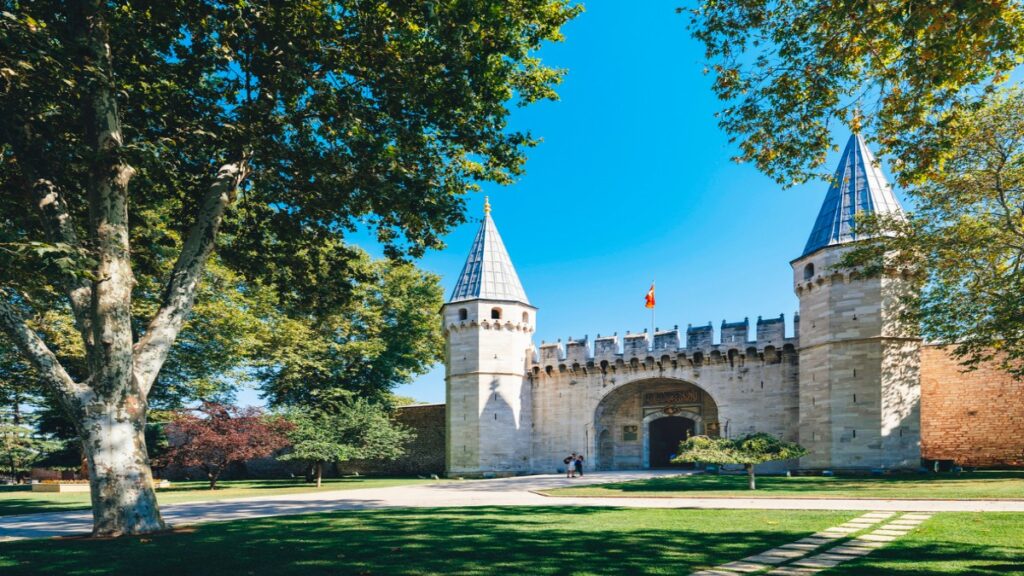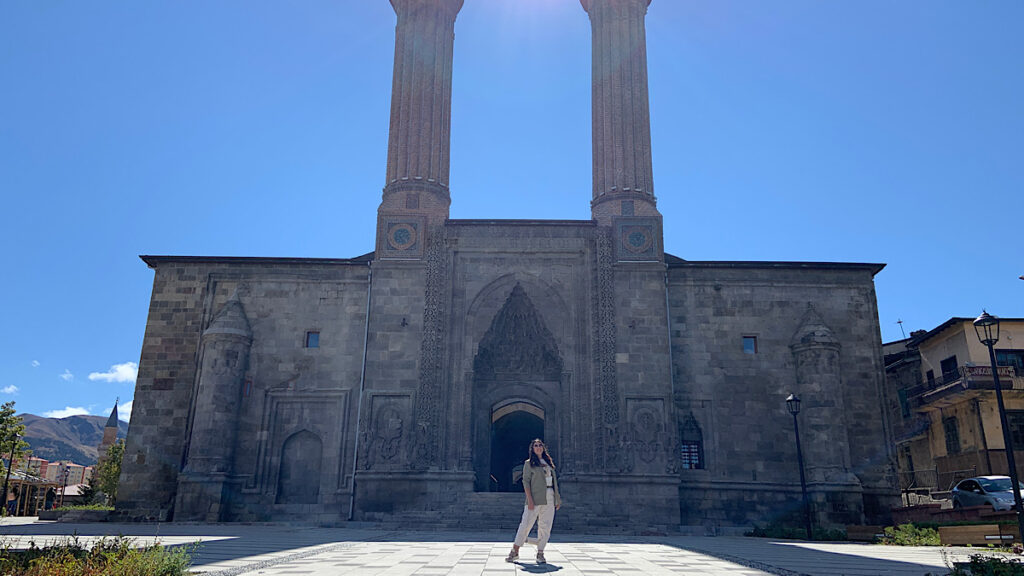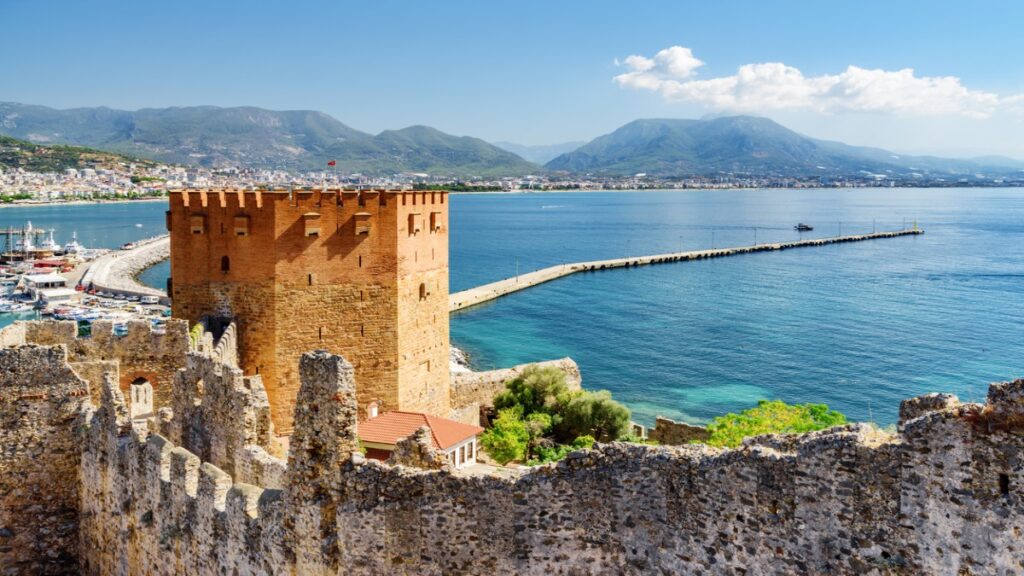
Historical Beauties of Turkey | The 17 Most Beautiful Places
Turkey’s historical sites are the greatest riches of our country, which attracts attention with its hundreds of years of cultural heritage. These places take visitors on an unforgettable journey into the past.
The historical peninsula of Istanbul, the fairy chimneys of Cappadocia, the ruins of the ancient city of Ephesus, the sculptures on Mount Nemrut, the ruins of Ani and many more are the favourite places to discover Turkey’s historical and cultural richness. Turkey’s historical beauties will fascinate you with its rich past and make you want to hit the road.
Turkey’s Historical Beauties Map
Turkey’s Historical Beauties Map
- Ephesus Ancient City
- Bodrum Castle and Underwater Archeology Museum
- Sumela Monastery
- Cappadocia
- The Hagia Sophia Mosque
- Sultan Ahmet Mosque
- Historical peninsula
- Topkapi Palace Museum
- Kaunos King Tombs
- Nemrut Mountain
- Aspendos Ancient Theater
- hattusas
- Mausoleum
- Göbeklitepe
- Erzurum Double Minareli Madrasa
- Zinciriye Madrasa
- Alanya Castle
From Past to Present: Historical Places and Beauties of Turkey
Turkey is a country famous for its historical richness. Situated on the Silk Road, our country has been home to many civilisations. The historical peninsula in Istanbul offers a particularly rich historical heritage as it was the capital of the Ottoman Empire. Historical buildings such as Ayasofia, Topkapi Palace, Suleymaniye Mosque and Grand Bazaar make Istanbul one of the most important tourism centres in the world.
Ancient cities in Anatolia are also among the historical beauties of Turkey. Ancient cities such as Ephesus, Pergamon, Miletus and the ruins of the Hellenistic and Roman periods take us on a journey through time. We are very lucky to live in these lands that host fascinating beauties. With its thousands of years of history, every corner of the geography we are in is almost like an open-air museum. Let’s take a look at Turkey’s 17 most special historical places, which consist of our historical places that foreign tourists also show a lot of interest. Our first stop is the ancient city of Ephesus.
Ancient City of Ephesus – Izmir

Ephesus Ancient City is a historical settlement in Izmir and one of the largest ancient cities in the world. Founded by the Ionian civilisation in the 6th century BC, Ephesus was one of the most important trade centres of the ancient world. Today, it is home to many historical buildings such as Ancient Theatre, Library of Celcius, Temple of Artemis, Agora, Hadrian Fountain.
The Basilica of St John in Ephesus was an important religious centre in the early Christian era and the Mother of God House is also located here. The rich and impressive history of the ancient city of Ephesus will take you back thousands of years. Ephesus, one of the most popular places among Turkey’s historical beauties, is a very special place that you should visit at the first opportunity if you have not seen it yet.
Bodrum Castle – Mugla

Bodrum Castle is a historical castle and museum in Bodrum district of Muğla. Built by the Persian Empire in the 4th century BC, the castle was later used during the Hellenistic, Roman and Byzantine periods. Bodrum Castle is also known as The Island of the Knights because it was used by the Knights Hospitaller in the 15th century.
A large part of the castle has survived until today. Today, the castle serves as the Underwater Archaeological Museum. While the remains of old shipwrecks and submarines are exhibited in the museum, there are also many exhibitions telling the history of the castle and the maritime history of Bodrum. Bodrum Castle has an important place among the historical beauties of Turkey. Bodrum I recommend you to spend a few hours during your holiday and see this historical heritage.
Sumela Monastery – Trabzon

Located in the Black Sea region, Sümela Monastery is one of the most impressive historical buildings of our country. The monastery was built in the 4th century and was used for hundreds of years. Located in a natural cave, the monastery is fascinating with its structure carved into the rocks and the frescoes on the facade.
The interior is specially designed for the performance of rituals. The region where the monastery is located, which is an important pilgrimage place for the Christian faith, offers a unique natural beauty.
Located at the foot of Mount Zigana, the monastery overlooks a valley between canyons. Sumela will fascinate you with both its historical and natural beauties.
Cappadocia – Nevsehir

Located in the centre of Turkey, Cappadocia is a region world-famous for its historical and natural beauty. One of the most distinctive features of Cappadocia is the natural rock formations called fairy chimneys. These formations have been shaped by wind and rain for thousands of years. In the region, which is also known for its underground cities and houses carved into the rocks, belief centres and monasteries were built in the early periods of Christianity.
Göreme Open Air Museum is one of the most important tourist attractions in the region. There are churches and monasteries carved into the rocks in the museum. Houses and churches carved into the rocks in Zelve Valley, Uçhisar Castle, Paşabağı are places you should definitely see. Underground cities such as Kaymaklı and Derinkuyu are among the most interesting historical places in the region.
Hagia Sophia Mosque – Istanbul

Hagia Sophia, one of the most important buildings of Istanbul, is one of the historical beauties of Turkey. First built as a church by the Byzantine Emperor Justinian I in 537, it has been used for various purposes throughout history. Hagia Sophia was converted into a mosque during the Ottoman Empire. The building has gained worldwide fame with its historical and architectural features.
The mosaics in the interior are among the most important examples of Byzantine Empire artworks. Hagia Sophia was converted into a mosque by Fatih Sultan Mehmed after the conquest of Istanbul. Used as a museum since 1935, it started to serve as a mosque again with a decision taken in 2020. This historical heritage is one of the places we should all see before we die.
Sultan Ahmet Mosque – Istanbul

Sultan Ahmet Mosque is one of the most famous mosques in Istanbul. The mosque, whose construction started in 1609, was built by the Ottoman sultan Ahmed I. Designed by the architect Sedefkar Mehmet Aga, the mosque is one of the most important examples of Turkish-Islamic art. Famous for its blue mosaics, the mosque is also known as the “Blue Mosque“.
The mosque is also important with its interior decorations and mosaics. There are over 20 thousand tiles, examples of calligraphy and other decorations inside. The dome of the mosque is one of the largest domes in the world with a diameter of 23.5 metres. The mosque, which is one of the most touristic places of Istanbul and visited by millions of tourists annually, makes an important contribution to the historical texture of the city.
Historical Peninsula – Istanbul

The Historical Peninsula, one of the historical beauties of Turkey, is one of the most important historical heritages of the world. The historical peninsula of Istanbul contains important buildings bearing the traces of the Byzantine and Ottoman Empires.
On the peninsula, there are legendary historical heritages such as Hagia Sophia, Topkapi Palace, Blue Mosque, Grand Bazaar, Basilica Cistern. These historical buildings take you on a historical journey while making you feel the historical texture and culture of Istanbul.
Topkapi Palace – Istanbul

One of the largest and most important palaces of the Ottoman Empire, Topkapi Palace, was built by Mehmed the Conqueror in the late 15th century. The palace was the place where the Ottoman sultans lived and managed state affairs for about 400 years.
Topkapi Palace is an extensive complex. Inside the palace, there are the harem apartments of the sultans, administrative buildings, various courtyards, gardens and museums. The museums of the palace exhibit many works of art from the Ottoman period.
Topkapı Palace Museum has priceless jewellery, weapons, clothes and manuscript books belonging to the Ottoman Empire. Topkapı Palace, one of the most important historical heritage of our country, must be seen.
Kaunos Rock Tombs – Mugla

Kaunos is an ancient city located in the ancient Lycian region and is located right next to the Dalyan River today. The city was ruled by Caria, Lydia, Persian Empire, Hellenistic kingdoms and Roman Empire throughout its history. One of the most remarkable features of Kaunos is the Kaunos Rock Tombs, which was used as an important cemetery in ancient times.
These tombs were carved in the high rocky parts of the river banks and are of various sizes and designs. Some of them are quite large and have very interesting details both architecturally and artistically. Although there are many special historical places on our list, one of the places that impressed me the most is Kaunos Rock Tombs.
Well, while you are here, you can read my Dalyan travel guide content and get the best of Dalyan. 😍
Mount Nemrut – Adıyaman

Nemrut Mountain is one of the first places that comes to mind among the historical and touristic places in Turkey. It is home to an ancient temple complex built by the Commagene Kingdom in the 2nd century BC. The most remarkable feature of this place is the gigantic statues in the temple complex. These statues depict gods, kings and other important figures.
This temple complex, built during the Kommagene Kingdom, is considered one of the most impressive cult centres of the ancient world. The temple complex was also used during the Roman Empire.
When you visit Mount Nemrut, you will be speechless among the magnificent views and historical ruins. Climbing Mount Nemrut, hiking and watching the sunrise or sunset is a must here. Mount Nemrut, one of the most important touristic spots of our southeastern region, was included in the UNESCO World Heritage list in 1987.
Aspendos Ancient Theatre – Antalya

Aspendos is an ancient Roman theatre located in Antalya province. Built in the 2nd century AD, the theatre is architecturally quite impressive and still largely preserved to this day.
The theatre has a capacity of about 15,000 spectators and its acoustics are so good that even today it is used for concerts, musical performances and other events. The theatre is open all year round and you should definitely make your way to Antalya to see the historical ruins and architectural wonder.
Hattusa – Corum

Hattushas is an ancient Hittite city in Çorum. It was used as the capital of the Hittite Empire from the 17th century BC. Hattusa was once one of the largest and most important cities of the ancient world.
Hattusa has great historical importance as it is one of the most important centres of the Hittite Empire. In this ancient city, many historical ruins and structures have survived to the present day. Among the most important ruins of the city are Great Temple, Sun Gate, Royal Palace and Cuneiform Archive.
Hattusa, one of the most important historical monuments of Turkey, is a very popular touristic place due to its historical and archaeological importance. The city, which is on the UNESCO World Heritage List due to its efforts to protect and promote Turkey’s historical heritage, is definitely a must-see place in Çorum.
Anitkabir – Ankara

Located among the historical beauties of Turkey, Anıtkabir has an important place in Turkey’s modern history. Built in memory of Mustafa Kemal Atatürk, Anıtkabir is the largest mausoleum in Turkey and many of the important events in Turkish history are commemorated here. The construction of Anıtkabir was completed in 1953.
Anıtkabir is one of the most important examples of Turkish architecture and sculpture. The Mausoleum, Anıtkabir Museum and Towers in Anıtkabir tell the modern history of Turkey. Anıtkabir is one of the most important places among Turkey’s historical and cultural heritage. If you visit on one of our national holidays or on 10 November, you will feel the atmosphere there to your bones.
Göbeklitepe – Şanlıurfa

One of the most important archaeological discoveries in recent years, Göbeklitepe is referred to as the beginning of history and hosts many visitors every day in Şanlıurfa. Göbeklitepe, which is mentioned as the place where civilisation began, is one of the most important historical sites in our country with its 12,000 years of history.
Göbeklitepe is the oldest known temple complex in world history. Dating back to 10,000 BC, it is one of the oldest cultural structures in human history. This temple complex offers important clues about the belief systems, rituals and social structures of humanity.
More than 20 temples, standing stones, reliefs and wall paintings in Göbeklitepe show how people had a belief system during the struggle for survival and how these beliefs affected their lives. Be sure to visit this important place that sheds light on the history of humanity. Where to visit in Şanlıurfa My article will guide you, do not set off without reading it.
Double Minaret Madrasa – Erzurum

Erzurum Double Minaret Madrasa is a Seljuk period building located in the historical centre of Erzurum city. Built in the 13th century, the madrasa is one of the most beautiful examples of Seljuk architecture and has an important place for Turkish history and culture. The name of the madrasah comes from the two minarets at the entrance gate of the building. The madrasa was also used during the Ottoman period and was last restored in the 1970s.
A pool in the inner courtyard, a fountain in the centre of the courtyard and 24 small rooms around the courtyard are the details of the madrasah. Erzurum Double Minaret Madrasa has an important place among Turkey’s historical and cultural heritage. This heritage, which has survived to the present day by preserving its historical texture, should be on your list of places to see.
Erzurum’da gezilecek yerler için bu bağlantıma göz atmanızda fayda var. Çok detaylı bir yazı hazırladım. Eminim faydalı olacaktır.
Zinciriye & Kasımiye Madrasa – Mardin

Zinciriye & Kasımiye Madrasah is a madrasah complex in Mardin and belongs to the Artuqid period. Built in the 14th century, the madrasa was designed and built by the leading architects of the period. The name of the madrasah comes from the Zinciriye and Kasımiye mosques. The madrasa was used for education and training activities during its period and has been preserved to a great extent until today.
The courtyard inside the madrasa is home to works of art from different periods. In addition, the library of the madrasah is also an important heritage and manuscript books from ancient times are kept here. Zinciriye & Kasımiye Madrasah, which makes an important contribution to the historical texture of Mardin, has an important place among Turkey’s historical and cultural heritage.
Alanya Castle – Antalya

The last beauty on my list of Turkey’s historical beauties is Alanya Castle, a historical castle complex. The castle is an important example of Seljuk architecture and was built in the 13th century. It is located on a hill overlooking the Mediterranean Sea. The castle complex contains historical mosques, cisterns, towers and fortifications.
A magnificent sea view you will see from Alanya Castle is also memorable. The castle complex has survived to the present day by undergoing various additions and renovations in both Seljuk and Ottoman periods.
In this article, I have only touched upon a few of Turkey’s historical sites: ancient cities of Anatolian civilisations, buildings bearing the traces of the Ottoman Empire and mosques reflecting the richness of Islamic culture. There are many more historical and natural beauties to discover in every corner of Turkey. I hope my article has encouraged you to explore the rich history of our country and visit these places. 😊
Historical Beauties of Turkey FAQ
What are three historical figures from Turkey?
Three historical figures from Turkey are:
Mustafa Kemal Atatürk: He was the founder of the Republic of Turkey and its first president. Atatürk led the Turkish War of Independence, which resulted in the establishment of modern Turkey and the abolition of the Ottoman Sultanate. He initiated numerous reforms aimed at modernizing Turkey, including the adoption of Western legal systems, secularization of the state, and promotion of women’s rights.
Rumi (Mevlana Jalaluddin Rumi): A 13th-century Persian poet, Islamic scholar, and mystic who spent most of his life in Konya, Turkey. Rumi’s poetry, particularly his work “Mathnawi” and his collection of poems known as the “Divan-e Shams-e Tabrizi,” has had a profound influence on Turkish culture and spirituality. He is widely revered in Turkey and around the world for his teachings on love, spirituality, and inner transformation.
Suleiman the Magnificent (Süleyman I): He was the tenth and longest-reigning Sultan of the Ottoman Empire, ruling from 1520 until his death in 1566. Suleiman is known for his military conquests, administrative reforms, and patronage of the arts and architecture. Under his rule, the Ottoman Empire reached its zenith, expanding its territories into Europe, the Middle East, and North Africa. Suleiman is often remembered as one of the most influential and powerful rulers in Turkish and Islamic history.
What is the most historic place in Turkey?
One of the most historic places in Turkey is Istanbul, particularly the area surrounding the Hagia Sophia.
Why is Turkey so historical?
Turkey’s historical significance stems from its strategic location as a bridge between continents, hosting diverse civilizations and empires throughout millennia. The legacies of ancient civilizations, Byzantine and Ottoman Empires, and Atatürk’s reforms in the 20th century collectively contribute to Turkey’s rich historical tapestry.




